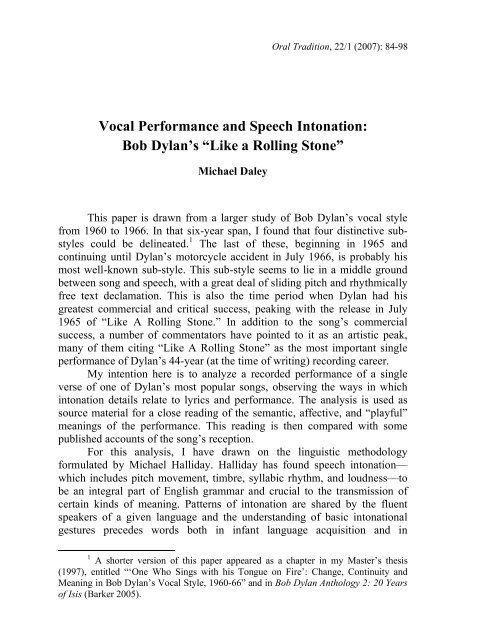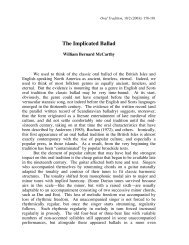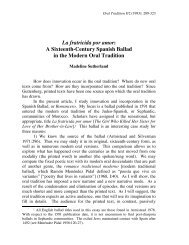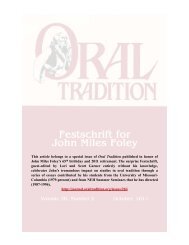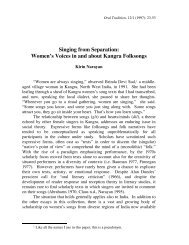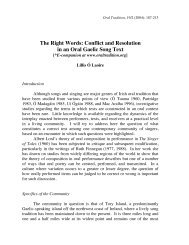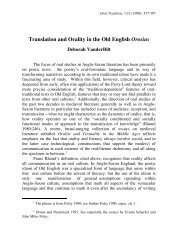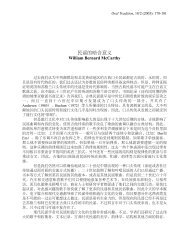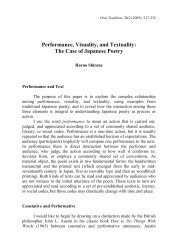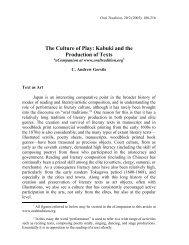Vocal Performance and Speech Intonation: Bob ... - Project MUSE
Vocal Performance and Speech Intonation: Bob ... - Project MUSE
Vocal Performance and Speech Intonation: Bob ... - Project MUSE
Create successful ePaper yourself
Turn your PDF publications into a flip-book with our unique Google optimized e-Paper software.
Oral Tradition, 22/1 (2007): 84-98<br />
<strong>Vocal</strong> <strong>Performance</strong> <strong>and</strong> <strong>Speech</strong> <strong>Intonation</strong>:<br />
<strong>Bob</strong> Dylan’s “Like a Rolling Stone”<br />
Michael Daley<br />
This paper is drawn from a larger study of <strong>Bob</strong> Dylan’s vocal style<br />
from 1960 to 1966. In that six-year span, I found that four distinctive substyles<br />
could be delineated. 1 The last of these, beginning in 1965 <strong>and</strong><br />
continuing until Dylan’s motorcycle accident in July 1966, is probably his<br />
most well-known sub-style. This sub-style seems to lie in a middle ground<br />
between song <strong>and</strong> speech, with a great deal of sliding pitch <strong>and</strong> rhythmically<br />
free text declamation. This is also the time period when Dylan had his<br />
greatest commercial <strong>and</strong> critical success, peaking with the release in July<br />
1965 of “Like A Rolling Stone.” In addition to the song’s commercial<br />
success, a number of commentators have pointed to it as an artistic peak,<br />
many of them citing “Like A Rolling Stone” as the most important single<br />
performance of Dylan’s 44-year (at the time of writing) recording career.<br />
My intention here is to analyze a recorded performance of a single<br />
verse of one of Dylan’s most popular songs, observing the ways in which<br />
intonation details relate to lyrics <strong>and</strong> performance. The analysis is used as<br />
source material for a close reading of the semantic, affective, <strong>and</strong> “playful”<br />
meanings of the performance. This reading is then compared with some<br />
published accounts of the song’s reception.<br />
For this analysis, I have drawn on the linguistic methodology<br />
formulated by Michael Halliday. Halliday has found speech intonation––<br />
which includes pitch movement, timbre, syllabic rhythm, <strong>and</strong> loudness––to<br />
be an integral part of English grammar <strong>and</strong> crucial to the transmission of<br />
certain kinds of meaning. Patterns of intonation are shared by the fluent<br />
speakers of a given language <strong>and</strong> the underst<strong>and</strong>ing of basic intonational<br />
gestures precedes words both in infant language acquisition <strong>and</strong> in<br />
1 A shorter version of this paper appeared as a chapter in my Master’s thesis<br />
(1997), entitled “‘One Who Sings with his Tongue on Fire’: Change, Continuity <strong>and</strong><br />
Meaning in <strong>Bob</strong> Dylan’s <strong>Vocal</strong> Style, 1960-66” <strong>and</strong> in <strong>Bob</strong> Dylan Anthology 2: 20 Years<br />
of Isis (Barker 2005).
85 MICHAEL DALEY<br />
evolutionary brain development. That is, intonation is a lower brain function<br />
than word recognition, <strong>and</strong> thus develops as a perceptual tool much earlier.<br />
<strong>Speech</strong> intonation is a deeply rooted <strong>and</strong> powerfully meaningful aspect of<br />
human communication. It is plausible that a system so powerful in speech<br />
might have some bearing on the communication of meaning in sung<br />
performance. This is the premise by which I am applying Halliday’s<br />
methods to this performance.<br />
The musical object in question is the originally released studio<br />
recording of “Like A Rolling Stone,” a performance that has generated much<br />
discussion among Dylan’s commentators <strong>and</strong> fans. I begin with a short<br />
history of the song’s reception among critics <strong>and</strong> fans, as well as some<br />
assessments of Dylan himself.<br />
“Like A Rolling Stone” was recorded on June 16, 1965 <strong>and</strong> was<br />
released as a single on July 20 th of the same year, later appearing on the<br />
album Highway 61 Revisited. It was an immediate success, eventually<br />
climbing to number two on the Billboard pop chart <strong>and</strong> number one on the<br />
Cashbox chart. The song was somewhat different from the top ten fare of the<br />
time, however. At a length of over six minutes (it was chopped for radio<br />
play) it was significantly longer than the two-<strong>and</strong>-a-half to three minute<br />
st<strong>and</strong>ard length then dominating pop radio, with a raucous guitar <strong>and</strong> organbased<br />
arrangement <strong>and</strong> four verses of dense, rapid-fire verbiage. It is<br />
generally agreed upon by commentators that the lyrics––at least on the<br />
surface––recount the privileged upbringing <strong>and</strong> subsequent fall into<br />
desperate poverty an unnamed “Miss Lonely.” The narrator’s accusations<br />
<strong>and</strong> unflattering observations are couched in a series of declarative<br />
statements <strong>and</strong> questions, culminating after each verse in the famous refrain:<br />
“How does it feel / to be on your own / with no direction home / a complete<br />
unknown / like a rolling stone” (there are slight variations in the refrain from<br />
stanza to stanza). Perhaps the most strikingly unique aspect of the record is<br />
Dylan’s vocal performance, with its use of nasal, sliding pitches <strong>and</strong> a<br />
speech-like, highly rhythmic declamatory style. Dylan later described, in<br />
somewhat stylized terms, the genesis of the song (to Jules Siegel, quoted in<br />
Scaduto 1973:244-5):<br />
I wrote it as soon as I got back from Engl<strong>and</strong>. It was ten pages long. It<br />
wasn’t called anything, just a rhythm thing on paper––all about my steady<br />
hatred directed at some point that was honest. In the end it wasn’t hatred.<br />
Revenge, that’s a better word. It was telling someone they didn’t know<br />
what it was all about, <strong>and</strong> they were lucky. I had never thought of it as a<br />
song, until one day I was at the piano, <strong>and</strong> on paper it was singing “How<br />
does it feel?” in a slow motion pace, in the utmost of slow motion. It was<br />
like swimming in lava. Hanging by their arms from a birch tree. Skipping,
DYLAN’S “LIKE A ROLLING STONE” 86<br />
kicking the tree, hitting a nail with your foot. Seeing someone in the pain<br />
they were bound to meet with. I wrote it. I didn’t fail. It was straight.<br />
Whether or not one chooses to take Dylan’s comments at face value, they<br />
provide us with a sense of the artist’s own perception of his creative process<br />
<strong>and</strong> the degree to which the endeavor succeeded. They also give us a<br />
glimpse into the visual <strong>and</strong> gestural correlatives of Dylan’s sonic sense; he<br />
refers here to outward movement, directed towards a specific point. These<br />
metaphors, I suggest, are not arbitrary. They are in fact strongly indexed to<br />
the metaphorical constructs of much of the reception of “Like A Rolling<br />
Stone,” as well as to the gestural aspects of Dylan’s use of vocal pitch in the<br />
performance.<br />
In addition to the popular acclaim accorded to Dylan’s recording, a<br />
steady procession of commentators on Dylan’s life <strong>and</strong> work have offered<br />
their own assessments. The larger works from which the following<br />
quotations are drawn include Dylan biographies, shorter articles, <strong>and</strong> more<br />
scholarly analytical works, in the cases of Mellers <strong>and</strong> Bowden (Scaduto<br />
1973:245):<br />
When you heard “Rolling Stone” back then it was like a cataclysm, like<br />
being taken to the edge of the abyss, drawn to some guillotine of<br />
experience. . . . [Dylan was] biting off a word, spitting out venom,<br />
spreading a virulent emotion, infecting the listener. . .<br />
Patrick Humphries (Humphries <strong>and</strong> Bauldie 1991:57):<br />
. . . steamrollering all that had gone before <strong>and</strong> spiraling onwards through<br />
outrageous rhymes <strong>and</strong> meter, lyrics flung like accusations, affronting yet<br />
compelling, that age-old fascination which lures unwary travelers right to<br />
the heart of darkness. . .<br />
John Herdman (1982:14):<br />
Rock bottom intensity of feeling. . . he tells us what he feels himself, he<br />
projects himself with eerie immediacy into the feelings of others, <strong>and</strong> in so<br />
doing he shows us what we feel too.<br />
Paul Nelson (1966:107):<br />
The definitive statement that both personal <strong>and</strong> artistic fulfillment must<br />
come, in the main, by being truly on one’s own.
87 MICHAEL DALEY<br />
Betsy Bowden (1982:104):<br />
. . . the absence of any personal pronouns [sic] sucks the listener into the<br />
song . . . the song’s “you” gets thoroughly conquered in both sense <strong>and</strong><br />
sound. . .<br />
Wilfred Mellers (1985:140):<br />
Although the words are dismissive, the music––with its jaunty repeated<br />
notes <strong>and</strong> eyebrow-arching rising thirds . . .is positive in total effect.<br />
“Hugh Dunnit” writing in The Telegraph, a <strong>Bob</strong> Dylan fan magazine<br />
(quoted in Williams 1991:153):<br />
. . . his birth cry is the primal demon voice that whoops out the surging<br />
refrains of this song. . .each is a searing, vituperative taunt, designed to<br />
needle to the bone. But the tone of the words (as sung) <strong>and</strong> music is<br />
unmistakably joyous, celebratory. [Dylan] is exultant, free, on his own,<br />
ecstatic that he is as he once was, a complete unknown––unknown<br />
because unknowable.<br />
While these assessments are rather broadly variant in tone <strong>and</strong><br />
content, some recurring themes are discernible. I have grouped some salient<br />
metaphors <strong>and</strong> descriptors from the critical history of “Like A Rolling<br />
Stone” (including Dylan’s own commentary) into five main thematic areas<br />
below:<br />
Thematic area 1: Strong antagonism<br />
“venom”<br />
“dismissive”<br />
“affronting”<br />
Thematic area 2: Attractiveness<br />
“sucks the listener in”<br />
“lures unwary travelers”<br />
“compelling”<br />
siren song metaphor<br />
“drawn to some guillotine of experience”<br />
Thematic area 3: Positive message<br />
“joyous . . .exultant . . .celebratory”<br />
“personal <strong>and</strong> artistic fulfillment”<br />
Thematic area 4: <strong>Project</strong>ing<br />
Thrusting outward
“spitting out venom”<br />
“lyrics flung”<br />
“directed at some point”<br />
“whoops out”<br />
“spiraling onwards”<br />
DYLAN’S “LIKE A ROLLING STONE” 88<br />
Thematic area 5: Sureness/effectiveness<br />
Virtuosity<br />
Intensity of feeling<br />
Expressivity<br />
“I wrote it. I didn’t fail. It was straight”<br />
Thematic area 1 parallels the mood <strong>and</strong> content of the lyrics as they<br />
appear on paper––a strong antagonism is conveyed through the constant,<br />
invasive questioning <strong>and</strong> damning judgments of the invisible first person<br />
(who may or may not be identified as Dylan himself). I would doubt,<br />
though, that the lyrics alone create such a strong mood of condemnation.<br />
Dylan’s overall vocal timbre here is quite hard <strong>and</strong> nasal, the kind of vocal<br />
sound that might accompany a “tongue-lashing” by someone who clearly<br />
feels that they are in the right, perhaps directed at a child or some other<br />
person in a position of lesser power. Such a tone suits this classic monologic<br />
text, where the life history <strong>and</strong> inner thoughts of “you” are co-opted by the<br />
narrator who is himself invisible, that is, unnamed, not described: an<br />
inviolable, inscrutable disembodied voice. 2 Much of Dylan’s expressive<br />
output around the time that “Like A Rolling Stone” was recorded displays a<br />
similar style of interpersonal communication. 3<br />
2 Mikhail Bakhtin described monologism, as opposed to dialogism, in this way:<br />
“Monologism, at its extreme, denies the existence outside itself of another consciousness<br />
with equal rights . . . . Monologue is finalized <strong>and</strong> deaf to the other’s response, does not<br />
expect it <strong>and</strong> does not acknowledge in it any decisive force” (quoted in Brackett 1995:7).<br />
Although I would characterize the lyrics as monologic, the song in performance takes on<br />
a dialogic character by virtue of the many layers of sound <strong>and</strong> the complexities of mass<br />
commercial dissemination.<br />
3 This kind of discursive control <strong>and</strong> venomous rhetorical skill can be observed in<br />
action in the classic film Don’t Look Back, a documentary about Dylan’s 1965 British<br />
tour immediately preceding the composition <strong>and</strong> recording of “Like A Rolling Stone.” A<br />
sequence in the film captures a conversation between Dylan <strong>and</strong> “the science student,” a<br />
young amateur journalist. Dylan immediately takes the student to task, questioning his<br />
inner motives, “turning around” the responses, toying with <strong>and</strong> effectively crushing his<br />
young victim with rhetoric. This seems to have been a favorite game at the time for<br />
Dylan <strong>and</strong> his cronies, a way of weeding out the unhip.
89 MICHAEL DALEY<br />
Thematic area 2 groups together references to the “attractiveness” of<br />
the performance, its power to draw the listener towards something that,<br />
when it is named at all, is vaguely dangerous or forbidding. Humphries<br />
seems to refer to the ancient Greek myth of the Sirens, who lured travelers<br />
towards destruction with an irresistible song. Scaduto, perhaps specifying<br />
the nature of the destruction, refers to a “guillotine of experience,” which<br />
might suggest that the listener experiences some irrevocable change in<br />
worldview once drawn into “the abyss.” These types of metaphors are<br />
difficult to reconcile with the sense of the lyrics as written, so it seems that<br />
this theme of “attractiveness” might be connected in some way with<br />
thematic area 5, which is concerned with virtuosic control. The “abyss”<br />
might be the potentiality of the listener herself being targeted for this kind of<br />
vitriol, while at the same time she is drawn to the source by the sheer<br />
mastery with which the antagonism is delivered.<br />
Thematic area 3, headed by “positive message,” primarily comes from<br />
Paul Nelson’s 1966 essay, which suggests that all of the characters in “Like<br />
A Rolling Stone” are actually all in some way Dylan himself. This theme<br />
was taken up in the Telegraph, whose author connects the performance with<br />
a projection of Dylan as triumphantly breaking the chains of his safe,<br />
successful “folksinger” career in favor of some new, uncharted musical<br />
terrain in the rock milieu. Thus the “story” of the verses is just a scaffolding<br />
upon which to hang the exultant chorus. Rather than chalking up this<br />
interpretation to creative critique, though, I would suggest that this, too, is an<br />
impression based on performative factors more than lyrical sense. The<br />
b<strong>and</strong>’s performance certainly helps matters along in this regard. There is<br />
nothing careful about the way the studio musicians barrel through the song,<br />
in spite of Al Kooper’s famous story (found in his autobiography, Backstage<br />
Passes) that this song marked the first time he ever played the organ. Dylan,<br />
too, contributes sloppily transcendent rhythm guitar <strong>and</strong> harmonica<br />
flourishes. The harmonic structure of the song itself can also be seen as a<br />
series of affirmations, with the verse consisting primarily of stepwise climbs<br />
from the I to the V chord, which is held until a satisfying return is made to<br />
the tonic I. The inevitable perfect cadences that begin each line of text are<br />
contradicted only once in the form, when a IV chord intervenes at the prechorus.<br />
This IV chord then reverses the movement of the previous lines,<br />
falling stepwise down to the I until the upward movement is restored with an<br />
extended II – IV – V climb. The choruses condense the stepwise climbs of<br />
the verses into terse I – IV – V statements that Dylan might have associated<br />
with the irony-free rock n’ roll aesthetics of “Twist <strong>and</strong> Shout” <strong>and</strong> “La<br />
Bamba.” I submit, then, that the commentators who associate “Like A
DYLAN’S “LIKE A ROLLING STONE” 90<br />
Rolling Stone” with joy, celebration, <strong>and</strong> liberation might be hearing these<br />
values primarily as embodied in the music, despite the fact that their critical<br />
faculties might impel them to look to the lyrics first.<br />
Thematic area 4 might be fruitfully compared to thematic area 2 in<br />
that they both seem connected to gesture, space, movement, <strong>and</strong> energy.<br />
Whereas area 2 contains metaphors of attraction, area 4 refers to outward<br />
projection, ostensibly from the same source that attracts. The references to<br />
“spitting out” <strong>and</strong> “lyrics flung” directs our attention towards the mouth, <strong>and</strong><br />
indeed Dylan referred to this song on a number of occasions as “vomitific.”<br />
Could this thematic area, along with area 2, be related to various listeners’<br />
connections with the corporeality of the performance? We hear Dylan’s<br />
mouth as he sings, but we can also envision his facial expression, perhaps<br />
his bodily movements as well. This we can deduce from the aural l<strong>and</strong>scape<br />
of the recording, which gives us information about Dylan’s vocal timbre, the<br />
speed of enunciation, <strong>and</strong> other details, but I believe that it is in the area of<br />
pitch that we will find the greatest correlation to gestural metaphors. As we<br />
will see, much of Dylan’s vocal pitch use in “Like A Rolling Stone” finds<br />
him taking a syllable <strong>and</strong> describing a kind of arc, with a medium or short<br />
rise <strong>and</strong> a longer fall. This somewhat parallels the spatial path of an object<br />
thrown into the air. And since Dylan performs this arc repeatedly, sometimes<br />
several times in a single line of text, it follows that a listener might hear the<br />
words as “flung,” or even “spiraling outwards,” as each arc is succeeded by<br />
another.<br />
Thematic area 5 contains metaphors of “sureness” <strong>and</strong><br />
“effectiveness,” connected with what might be thought of as virtuosic<br />
expressive control. Robert Walser has traced the eighteenth-century origins<br />
of the term “virtuoso,” a word that is popularly thought of as referring to<br />
technical mastery. Walser points out that this technical mastery was always<br />
in the service of expressive <strong>and</strong> rhetorical control. 4 The ways that this<br />
virtuosity is manifested in “Like A Rolling Stone” are twofold. As I hope to<br />
demonstrate, Dylan uses vocal pitch to emphasize the lyric sense––this may<br />
be interpreted as a rhetorical use of performative virtuosity. But his division<br />
of phrases does not always serve the “sense” of the discourse; on the<br />
contrary, his re-alignment of points of emphasis in the lyrics, again through<br />
pitch use, can be understood as playful. The virtuoso makes meaningful<br />
performances, but he also shows off what he can do. By sometimes<br />
obscuring meaning, he displays his mastery.<br />
A close reading of Dylan’s vocal performance in “Like A Rolling<br />
Stone” will allow for a better underst<strong>and</strong>ing of the metaphorical<br />
4 See Walser 1993.
91 MICHAEL DALEY<br />
constructions that followed in its wake, in the form the critical responses<br />
recounted above. This close reading will consist mainly of an analysis of<br />
pitch use in the second verse <strong>and</strong> chorus based on Michael Halliday’s<br />
linguistic method. First, though, a word on Halliday’s method.<br />
Through much of the history of linguistic inquiry, the written word<br />
has occupied a privileged place as an object of study. Languages are<br />
traditionally analyzed primarily in terms of their grammars; this reflects the<br />
popular belief that words <strong>and</strong> sentences constitute the essential part of<br />
human verbal communication. As such, spoken language is routinely<br />
transcribed to written form for analysis. Of course, popular knowledge also<br />
tells us that “how you say something is often as important as what you say.”<br />
Every native speaker of English performs the language in some way that<br />
communicates things that the written word cannot. The scientific<br />
underst<strong>and</strong>ing of this “sonic sense” of speech, however, has developed<br />
slowly <strong>and</strong> fitfully until recent years.<br />
As early as the 1930s, work began to be undertaken towards the<br />
underst<strong>and</strong>ing of speech intonation, the universe of sonic details that<br />
accompany every utterance. These details include large <strong>and</strong> small gradations<br />
in pitch, timbre, amplitude, <strong>and</strong> rhythm. The British linguist Michael<br />
Halliday has formulated a cogent system for underst<strong>and</strong>ing speech<br />
intonation in the context of a “functional” English grammar in his 1970<br />
monograph A Course in Spoken English: <strong>Intonation</strong>, <strong>and</strong> his larger work<br />
from 1994, An Introduction to Functional Grammar. Since Halliday’s work<br />
on the nature of speech has constituted one of the starting points for my own<br />
research, I include here a thumbnail explanation of his theory as it applies to<br />
the present work. The following short explanation is a paraphrase of some of<br />
the ideas put forth in Halliday’s 1970 <strong>and</strong> 1994 publications, with an aim<br />
towards setting the stage for the analysis here.<br />
Tonality<br />
<strong>Intonation</strong> in English is organized in units Halliday calls tone groups.<br />
Halliday (1970: 3-4) says of the tone group:<br />
The tone group is one unit of information, one “block” in the message that<br />
the speaker is communicating; <strong>and</strong> so it can be of any length. The<br />
particular meaning that the speaker wishes to convey may make it<br />
necessary to split a single clause into two or more tone groups, or to<br />
combine two or more clauses into one tone group.
DYLAN’S “LIKE A ROLLING STONE” 92<br />
The pattern by which tone groups are distributed throughout speech, called<br />
tonality, is crucial to the sense of an utterance. The speaker divides up the<br />
stream of spoken words into groups, <strong>and</strong> this reveals to the listener how to<br />
mentally organize the information. Almost always, tonality follows a<br />
predictable course, with tone groups basically corresponding to grammatical<br />
clauses. But when it is disrupted, as in <strong>Bob</strong> Dylan’s 1965 studio<br />
performance of “Like A Rolling Stone,” grammatical sense can be<br />
fundamentally altered.<br />
Tonicity<br />
Each tone group has a tonic syllable, a place of prominence that the<br />
speaker seeks to mark as most important <strong>and</strong> that carries the most<br />
pronounced pitch change. It often carries the burden of “new information” in<br />
the clause <strong>and</strong>, as such, the normative place of a tonic syllable is on the last<br />
word in a clause. Placement of the tonic syllable in places other than this is<br />
understood to be contrastive. The placement of tonic prominence is referred<br />
to as tonicity.<br />
Tone<br />
Halliday has identified five basic tones, or pitch contours, in English. Tone<br />
interacts with tonality (distribution of tone groups) <strong>and</strong> tonicity (placement<br />
of tonic prominence) to create meaning in English intonation. Following are<br />
the tones identified in Halliday’s system:<br />
Simple Tone Groups:<br />
tone 1 falling<br />
tone 2 high rising, or falling-rising (pointed)<br />
tone 3 low rising<br />
tone 4 falling-rising (rounded)<br />
tone 5 rising-falling (rounded)<br />
I have transcribed the lyrics of the second verse <strong>and</strong> chorus of “Like A<br />
Rolling Stone” using an adaptation of Halliday’s notation for speech<br />
intonation. The second verse is not dissimilar to the other three verses in<br />
style, but I chose it because it seemed to me to contain the widest variety of<br />
playful inflections <strong>and</strong> pitch gestures. The tones themselves (the numerals<br />
that begin each tone group) were chosen on the basis of their resemblance to
93 MICHAEL DALEY<br />
Dylan’s use of sung pitch, as shown here. Each tone group is set off in a<br />
separate line of text <strong>and</strong> framed in double slash marks; syllables with tonic<br />
prominence are underlined, <strong>and</strong> rhythmic feet are divided by single slash<br />
marks.<br />
a) // 5 ah you // (rising, then falling, tone)<br />
b) // 1 gone // (falling tone)<br />
c) // 1 to the / finest //<br />
d) // 1 school //<br />
e) // 1 all //<br />
f) // 1 right //<br />
g) // 1’^miss / lonely / but you / know you / only / used to / get //<br />
h) // 5 juiced in / it //<br />
i) // 1 ^no/body’s / ever / taught / you / how to / live out / on / the street //<br />
j) // 5 ^<strong>and</strong> / now you’re / gonna / have to / get / used to //<br />
k) // 5 it //<br />
1) // 1 ^you / say you’d / never //<br />
m) // 1 compro / mise //<br />
n) // 1 with the / mystery / tramp but / now you //<br />
o) // 1 realize //<br />
p) // 1 he’s not / selling / any //<br />
q) // 1 alibis //<br />
r) // 1 as you / stare in / to the / vacuum / of his / eyes //<br />
s) // 1 <strong>and</strong> say //<br />
t) // 1 do you / want to //<br />
u) // 1 make a /deal //<br />
v) // 1 how does it / feel //
DYLAN’S “LIKE A ROLLING STONE” 94<br />
w) // 1 how does it / feel //<br />
x) // 1 to be / on your / own //<br />
y) // 1 ‘^with / no di / rection / home //<br />
z) // 2 a com / plete un / known //<br />
aa) // 2 like a / rolling / stone //<br />
Below I have transcribed the same verse <strong>and</strong> chorus “grammatically,” using<br />
line breaks to mark off likely clause divisions:<br />
ah you gone to the finest school all right miss lonely<br />
but you know you only used to get juiced in it<br />
nobody’s ever taught you how to live out on the street<br />
<strong>and</strong> now you’re gonna have to get used to it<br />
you say you’d never compromise with the mystery tramp<br />
but now you realize he’s not selling any alibis<br />
as you stare into the vacuum of his eyes<br />
<strong>and</strong> say “Do you want to make a deal?”<br />
How does it feel?<br />
How does it feel to be on your own<br />
with no direction home<br />
a complete unknown<br />
like a rolling stone?<br />
The verse begins with a tone 5 (line a). This being a tone group unto<br />
itself, it would be plausible to refer to this speech function as an initiating<br />
call; tone 5, in this case, has a meaning of “insistence.” This is the second<br />
verse, after all, which can be thought of as constituting an expansion of the<br />
ideas begun in the first. Thus the highly tonicized first pitch gesture of this<br />
verse might be interpreted as a kind of fanfare; musicologist Philip Tagg<br />
characterizes such strong upward pitch sweeps as “a call to attention <strong>and</strong><br />
action, a strong movement upward an outwards . . . energetic <strong>and</strong> heroic”<br />
(Tagg 1979:14).<br />
What follows is a rapid-fire series of Tone 1s. The use of the Tone 1<br />
pitch fall here is unremarkable in itself, but it is the tonicity characteristics<br />
that are unusual here. The listener is bombarded with a series of tonicized<br />
words (tonic prominence is used in normal speech as a pointer to the new<br />
information in an utterance) <strong>and</strong> Dylan gives tonic prominence to nearly<br />
every word in the first part of the first line. This overloading of new<br />
information pointers renders the text as forceful <strong>and</strong> intrusive upon the<br />
listener. There is a sense of an intoxicating sensory overload.
95 MICHAEL DALEY<br />
Right away a general non-alignment of tone groups as sung with the<br />
grammar of the written lyric is evident. This manifests itself in the<br />
distribution of tone groups in many different places within the grammatical<br />
clause, as well as the placement of tonic prominence on syllables other than<br />
the last lexical item in the clause. In tone groups e) <strong>and</strong> f) this unusual,<br />
seemingly indiscriminate use of tonality breaks up the cohesion of the phrase<br />
“all right,” a phrase that has become fused, or indivisible, through popular<br />
use. The phrase is rendered contrastive to its usual meaning <strong>and</strong> marks the<br />
word “all” as a piece of new information. This would force the clichéd<br />
phrase to be processed in terms of its actual meaning, rather than as a purely<br />
“textual” conjunctive phrase, which it has become in popular usage. Thus<br />
the listener hears “all right” as an emphatic confirmation of the text<br />
immediately preceding. This technique seeks to renew the cliché, something<br />
that Dylan has done lexically in other songs by substituting unexpected<br />
words in common phrases. 5<br />
It would be grammatically plausible to segment the first line of this<br />
verse into two clauses as follows:<br />
ah you gone to the finest school all right miss lonely<br />
but you know you only used to get juiced in it<br />
The second clause would usually be distributed over one tone group. This<br />
does not happen here, though not because of the overloading of tone groups<br />
that occurred in the first clause. Instead, the last part of the first clause<br />
(“miss lonely”) is included in the second clause’s tone group, which itself<br />
cuts off at “get,” rather than being completed with “juiced in it.” Thus the<br />
normative placement of the tone group on the clause is shifted backward by<br />
one phrase. This has the effect of presenting a grammatically incoherent<br />
group of words as a single package of information. This clouds the meaning<br />
of the clause somewhat, but perhaps more importantly it constitutes a poetic<br />
strike against grammar, at least as it appears in straight written narrative.<br />
Clearly Dylan, like Chuck Berry <strong>and</strong> others before him, is reveling in his<br />
virtuosic master of the medium of sung text.<br />
The next couple of lines contain relatively little in the way of pitch<br />
playfulness, even though symmetry would suggest that the pitch falls should<br />
continue at the same rate. Dylan, however, refuses to do the expected. When<br />
the chorus begins, tonic syllables seem to be in their proper places. But<br />
Dylan throws in a few more curveballs. Curiously, the last two lines are sung<br />
in contours similar to tone 2. This would seem to introduce a mood of<br />
5 See Ricks 1987.
DYLAN’S “LIKE A ROLLING STONE” 96<br />
questioning––tone 2 most often indicates uncertainty. But this coincides<br />
musically with the melodic resolution to the tonic, or home note, so the<br />
overall effect is that of closure.<br />
Close reading of the vocal performance of a song, as I have attempted<br />
here, can yield a good deal of information about how meaning is h<strong>and</strong>led<br />
beyond the lexical <strong>and</strong> grammatical levels of the lyrics. In the case of the<br />
second verse of “Like A Rolling Stone,” these prosodic details can be seen<br />
in the context of that song’s reception; intonational play <strong>and</strong> emphasis in the<br />
performance might be connected to perceptions of virtuosic expressive<br />
control, a sense of “expressivity” or “intensity of feeling,” <strong>and</strong> gestural<br />
metaphors such as “flung” <strong>and</strong> “spiralling outwards.” On the other h<strong>and</strong>,<br />
certain aspects of reception can be more precisely connected to other facets<br />
of the musical object: a sense of strong antagonism might be traced mainly<br />
to the lyrics, while a feeling of celebration <strong>and</strong> joy may be connected to the<br />
general raucousness <strong>and</strong> energy of the b<strong>and</strong>’s performance.<br />
Though I am certain that pitch in sung language does hold meaning in<br />
a significantly patterned way, I am also aware that singing is not speech, <strong>and</strong><br />
other factors do enter the semantic <strong>and</strong> affective l<strong>and</strong>scape of musical<br />
expression. Nonetheless, a look at Dylan’s use of pitch in this song, through<br />
the lens of linguistic speech intonation, goes a long way toward explaining<br />
the precise nature of Dylan’s communication of meaning in sung<br />
performance. One need only observe the many gestural <strong>and</strong> metaphorical<br />
correlations between the linguistic aspects of the performance <strong>and</strong> the effects<br />
of that performance (as recounted in the reception history) on listeners. A<br />
certain thoroughgoing nature of Dylan’s aesthetic is suggested here, with<br />
musical, linguistic, gestural, <strong>and</strong> (perhaps subsuming all of these)<br />
metaphorical aspects all articulating a cohesive, deeply embedded system of<br />
drives <strong>and</strong> directions. Postponing any further investigation into this broader<br />
inquiry for now, this analysis of vocal performance in the second verse of<br />
“Like A Rolling Stone” reveals much common ground between speech <strong>and</strong><br />
song in the transmission <strong>and</strong> reception of meaning, though the precise nature<br />
of this shared sign-system may only be understood through further<br />
interdisciplinary inquiry.<br />
References<br />
York University, Toronto<br />
Barker 2005 Derek Barker, ed. <strong>Bob</strong> Dylan Anthology 2: 20 Years of Isis,<br />
New Malden, Surrey: Chrome Dreams.
97 MICHAEL DALEY<br />
Bowden 1982 Betsy Bowden. Performed Literature: Words <strong>and</strong> Music by<br />
<strong>Bob</strong> Dylan. Bloomington: Indiana University Press. p. 104.<br />
Brackett 1995 David Brackett. Interpreting Popular Music. Cambridge:<br />
Cambridge University Press.<br />
Daley 1997 Michael Daley. “‘One Who Sings with his Tongue on Fire’:<br />
Change, Continuity <strong>and</strong> Meaning in <strong>Bob</strong> Dylan’s <strong>Vocal</strong><br />
Style, 1960-66.” Unpublished Master’s thesis. Toronto:<br />
York University.<br />
Halliday 1970 Michael Halliday. A Course in Spoken English: <strong>Intonation</strong>.<br />
Oxford: Oxford University Press. pp. 3-4.<br />
Halliday 1994 . An Introduction to Functional Grammar. London:<br />
Edward Arnold.<br />
Herdman 1982 John Herdman. Voice Without Restraint: A Study of <strong>Bob</strong><br />
Dylan’s Lyrics <strong>and</strong> Their Background. New York: Delilah<br />
Books. p. 14.<br />
Humphries <strong>and</strong> Bauldie Paul Humphries <strong>and</strong> John Bauldie. Absolutely <strong>Bob</strong> Dylan.<br />
1991 New York: Viking. p. 57.<br />
Mellers 1985 Wilfred Mellers. A Darker Shade of Pale: A Backdrop to<br />
<strong>Bob</strong> Dylan. Oxford: Oxford University Press. p. 140.<br />
Nelson 1966 Paul Nelson. “<strong>Bob</strong> Dylan: Another View.” In <strong>Bob</strong> Dylan: A<br />
Retrospective. Ed. by Craig McGregor. New York: William<br />
Morrow <strong>and</strong> Co. p. 107.<br />
Ricks 1987 Christopher Ricks. “Clichés That Come To Pass.” In All<br />
Across the Telegraph: A <strong>Bob</strong> Dylan H<strong>and</strong>book. Ed. by<br />
Gray, Michael <strong>and</strong> John Bauldie. London: Sidgwick <strong>and</strong><br />
Jackson. pp. 22-29.<br />
Scaduto 1973 Anthony Scaduto. <strong>Bob</strong> Dylan. New York: Signet. p. 245.<br />
Tagg 1979 Philip Tagg. Kojak: 50 Seconds of Television Music.<br />
Gothenburg: Skrifter fran Musikvetenskapliga Institionen.<br />
p. 14.<br />
Walser 1993 Robert Walser. Running With the Devil: Power, Gender,<br />
<strong>and</strong> Madness in Heavy Metal Music. Hanover, NH:<br />
Wesleyan University Press.
DYLAN’S “LIKE A ROLLING STONE” 98<br />
Williams 1991 <strong>Bob</strong> Dylan: Performing Artist: The Early Years: 1960-<br />
1973. Lancaster, PA: Underwood-Miller. p. 153.


